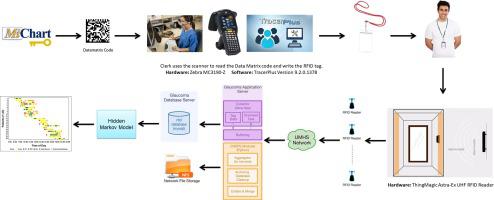当前位置:
X-MOL 学术
›
J. Biomed. Inform.
›
论文详情
Our official English website, www.x-mol.net, welcomes your feedback! (Note: you will need to create a separate account there.)
Designing and validating a low-cost real time locating system to continuously assess patient wait times.
Journal of Biomedical informatics ( IF 4.5 ) Pub Date : 2020-04-24 , DOI: 10.1016/j.jbi.2020.103428 Paula Anne Newman-Casey 1 , John Musser 1 , Leslie M Niziol 1 , Kerby Shedden 2 , David Burke 3 , Amy Cohn 4
Journal of Biomedical informatics ( IF 4.5 ) Pub Date : 2020-04-24 , DOI: 10.1016/j.jbi.2020.103428 Paula Anne Newman-Casey 1 , John Musser 1 , Leslie M Niziol 1 , Kerby Shedden 2 , David Burke 3 , Amy Cohn 4
Affiliation

|
OBJECTIVE
Outpatient clinics lack infrastructure to easily measure and understand patient wait times. Our objective was to design a low-cost, portable passive real time locating system within an outpatient clinic setting to measure patient wait times and patient-provider interactions.
MATERIALS AND METHODS
Direct observation was used to determine workflow in an outpatient glaucoma clinic at the University of Michigan. We used off-the shelf, antenna-integrated ultra-high frequency (UHF) RFID readers (ThingMagic, Astra-Ex, Woburn, MA) and UHF re-useable passive RFID tags (Zebra Impinj Monza 4QT, Seattle, WA). We designed a custom RFID management application in the Java programming language that was equipped with 'live' device administration to collect time and location data from patients and providers. These hardware choices enabled low cost system installation. Hidden Markov Modeling (HMM) was used to smooth patient and provider location data. Location data were validated against direct observations and EHR evaluation.
RESULTS
The HMM smoothed RFID system data accurately predicted patient location 80.6% of the time and provider location 79.1% of the time, compared to direct observation locations, an improvement over the raw RFID location data (65.0% and 77.9% accurate, respectively). Patient process time was on average 42.8 min (SD = 27.5) and wait time was 47.9 min (SD = 33.1). The installation and recurring capital costs of the system are approximately 10% of available commercially-supplied patient/provider tracking systems.
DISCUSSION
Passive RFID time study systems can enable real-time localization of people in clinic, facilitating continuous capture of patient wait times and patient-provider interactions. The system must be tailored to the clinic to accurately reflect patient and provider movement.
CONCLUSIONS
Capturing wait time data continuously and passively can empower continuous clinical quality improvement initiatives to enhance the patient experience.
中文翻译:

设计和验证低成本的实时定位系统,以连续评估患者的等待时间。
目的门诊诊所缺乏可轻松衡量和了解患者等待时间的基础设施。我们的目标是在门诊诊所环境中设计一种低成本的便携式被动实时定位系统,以测量患者的等待时间和患者与提供者之间的互动。材料与方法直接观察用于确定密歇根大学门诊青光眼诊所的工作流程。我们使用了现成的,天线集成的超高频(UHF)RFID阅读器(ThingMagic,Astra-Ex,Woburn,MA)和UHF可重复使用的无源RFID标签(Zebra Impinj Monza 4QT,华盛顿州西雅图)。我们使用Java编程语言设计了一个自定义RFID管理应用程序,该应用程序配备了“实时”设备管理功能,可以从患者和提供者那里收集时间和位置数据。这些硬件选择可实现低成本的系统安装。隐藏马尔可夫模型(HMM)用于平滑患者和提供者的位置数据。根据直接观察和EHR评估验证了位置数据。结果与直接观察位置相比,HMM平滑的RFID系统数据准确地预测了80.6%的患者位置和79.1%的时间提供者位置,这比原始RFID位置数据要准确(分别为65.0%和77.9%)。患者的平均处理时间为42.8分钟(标准差= 27.5),等待时间为47.9分钟(标准差= 33.1)。该系统的安装和经常性资本成本约为商业上提供的患者/提供者跟踪系统的10%。讨论被动式RFID时间研究系统可实现对诊所人员的实时定位,便于持续记录患者的等待时间和患者与提供者的互动。该系统必须针对诊所量身定制,以准确反映患者和提供者的运动。结论连续和被动地捕获等待时间数据可以使持续的临床质量改进计划得以实现,以增强患者体验。
更新日期:2020-04-24
中文翻译:

设计和验证低成本的实时定位系统,以连续评估患者的等待时间。
目的门诊诊所缺乏可轻松衡量和了解患者等待时间的基础设施。我们的目标是在门诊诊所环境中设计一种低成本的便携式被动实时定位系统,以测量患者的等待时间和患者与提供者之间的互动。材料与方法直接观察用于确定密歇根大学门诊青光眼诊所的工作流程。我们使用了现成的,天线集成的超高频(UHF)RFID阅读器(ThingMagic,Astra-Ex,Woburn,MA)和UHF可重复使用的无源RFID标签(Zebra Impinj Monza 4QT,华盛顿州西雅图)。我们使用Java编程语言设计了一个自定义RFID管理应用程序,该应用程序配备了“实时”设备管理功能,可以从患者和提供者那里收集时间和位置数据。这些硬件选择可实现低成本的系统安装。隐藏马尔可夫模型(HMM)用于平滑患者和提供者的位置数据。根据直接观察和EHR评估验证了位置数据。结果与直接观察位置相比,HMM平滑的RFID系统数据准确地预测了80.6%的患者位置和79.1%的时间提供者位置,这比原始RFID位置数据要准确(分别为65.0%和77.9%)。患者的平均处理时间为42.8分钟(标准差= 27.5),等待时间为47.9分钟(标准差= 33.1)。该系统的安装和经常性资本成本约为商业上提供的患者/提供者跟踪系统的10%。讨论被动式RFID时间研究系统可实现对诊所人员的实时定位,便于持续记录患者的等待时间和患者与提供者的互动。该系统必须针对诊所量身定制,以准确反映患者和提供者的运动。结论连续和被动地捕获等待时间数据可以使持续的临床质量改进计划得以实现,以增强患者体验。


























 京公网安备 11010802027423号
京公网安备 11010802027423号